Analyzing Intercultural Challenges in Global Sourcing Strategies
VerifiedAdded on 2023/06/13
|11
|2687
|108
Case Study
AI Summary
This case study examines the intercultural challenges faced by a Swedish company with a subsidiary in Vietnam, highlighting a conflict between the company's global sourcing guidelines and the cultural preferences of the Chinese manager of the subsidiary. The manager's preference for sourcing exclusively from Chinese suppliers, rooted in cultural values of trust and loyalty, clashes with the company's strategy of diversifying suppliers to mitigate dependency and ensure competitive pricing. The study emphasizes the importance of aligning business strategies with a multicultural workforce, addressing issues of miscommunication and the need for intercultural competency, including understanding cultural differences, adapting communication strategies, and promoting inclusivity and empathy. It suggests strategies such as breaking stereotypes, fostering inclusivity, and recognizing diversity to improve intercultural communication and create a more productive and harmonious work environment. Ultimately, the study underscores the necessity for companies to acknowledge and accommodate cultural differences to optimize the utility of a diverse workforce in the global business landscape. Desklib provides students with access to similar case studies and solved assignments to aid in their studies.
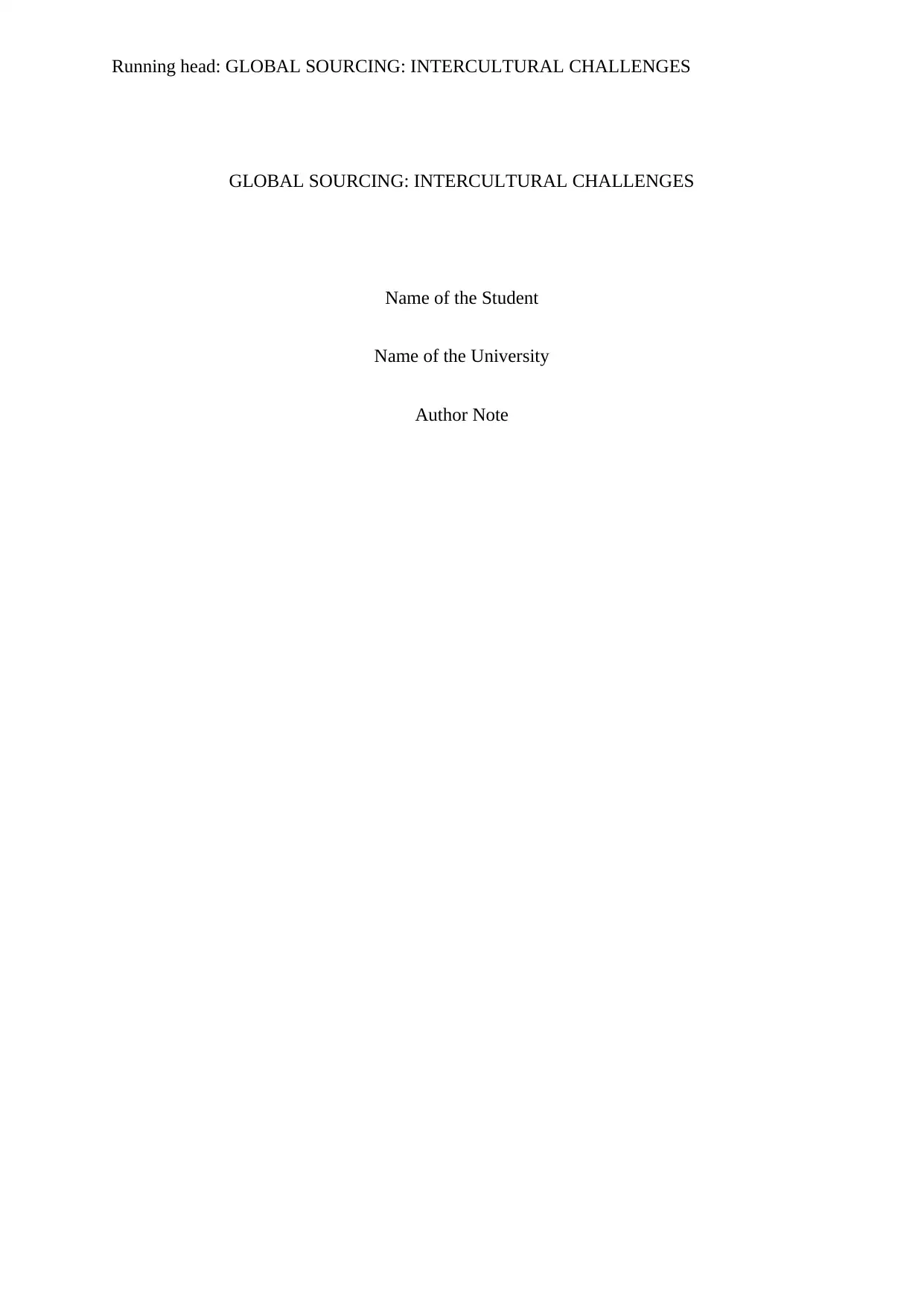
Running head: GLOBAL SOURCING: INTERCULTURAL CHALLENGES
GLOBAL SOURCING: INTERCULTURAL CHALLENGES
Name of the Student
Name of the University
Author Note
GLOBAL SOURCING: INTERCULTURAL CHALLENGES
Name of the Student
Name of the University
Author Note
Paraphrase This Document
Need a fresh take? Get an instant paraphrase of this document with our AI Paraphraser
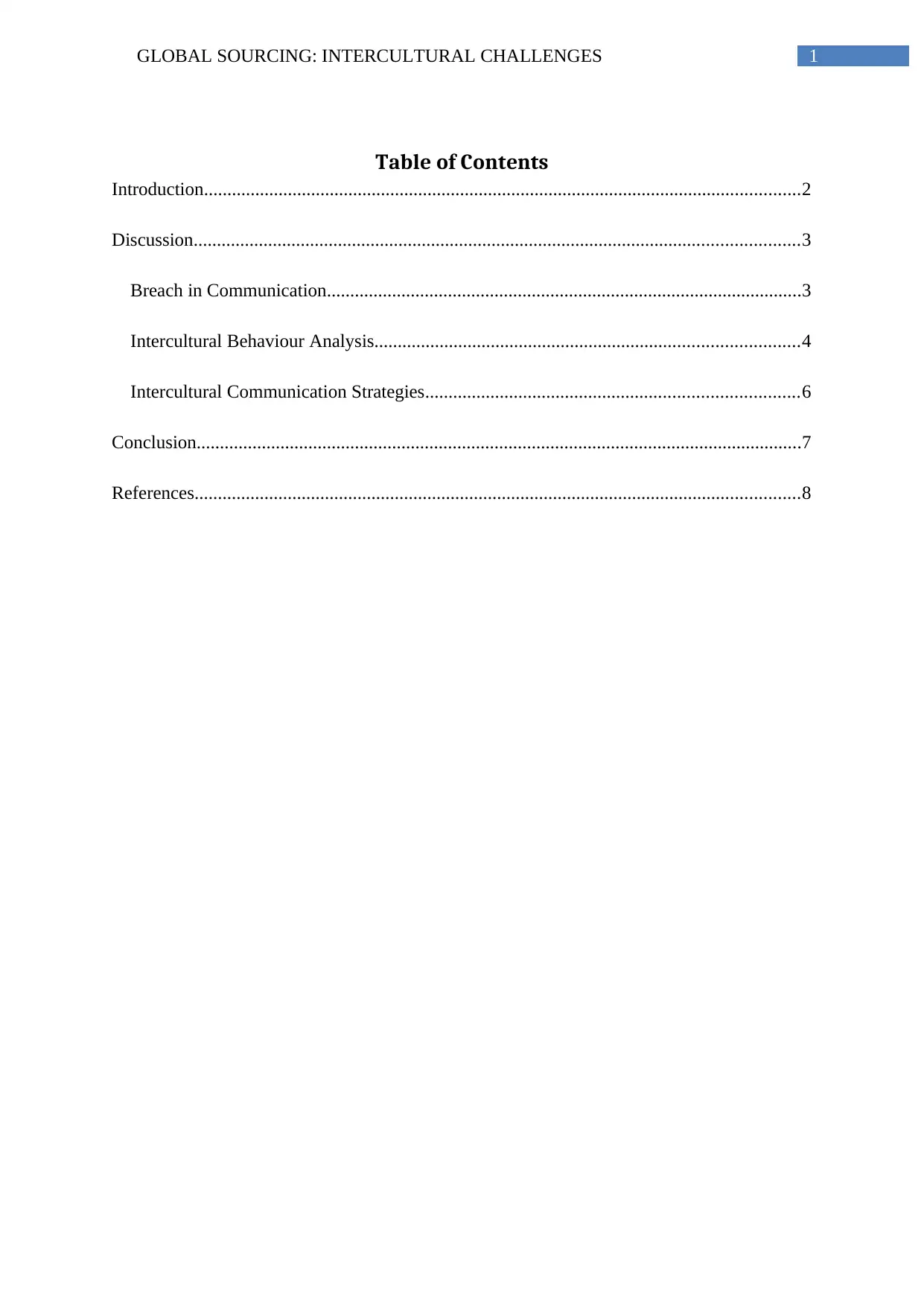
1GLOBAL SOURCING: INTERCULTURAL CHALLENGES
Table of Contents
Introduction................................................................................................................................2
Discussion..................................................................................................................................3
Breach in Communication......................................................................................................3
Intercultural Behaviour Analysis...........................................................................................4
Intercultural Communication Strategies................................................................................6
Conclusion..................................................................................................................................7
References..................................................................................................................................8
Table of Contents
Introduction................................................................................................................................2
Discussion..................................................................................................................................3
Breach in Communication......................................................................................................3
Intercultural Behaviour Analysis...........................................................................................4
Intercultural Communication Strategies................................................................................6
Conclusion..................................................................................................................................7
References..................................................................................................................................8
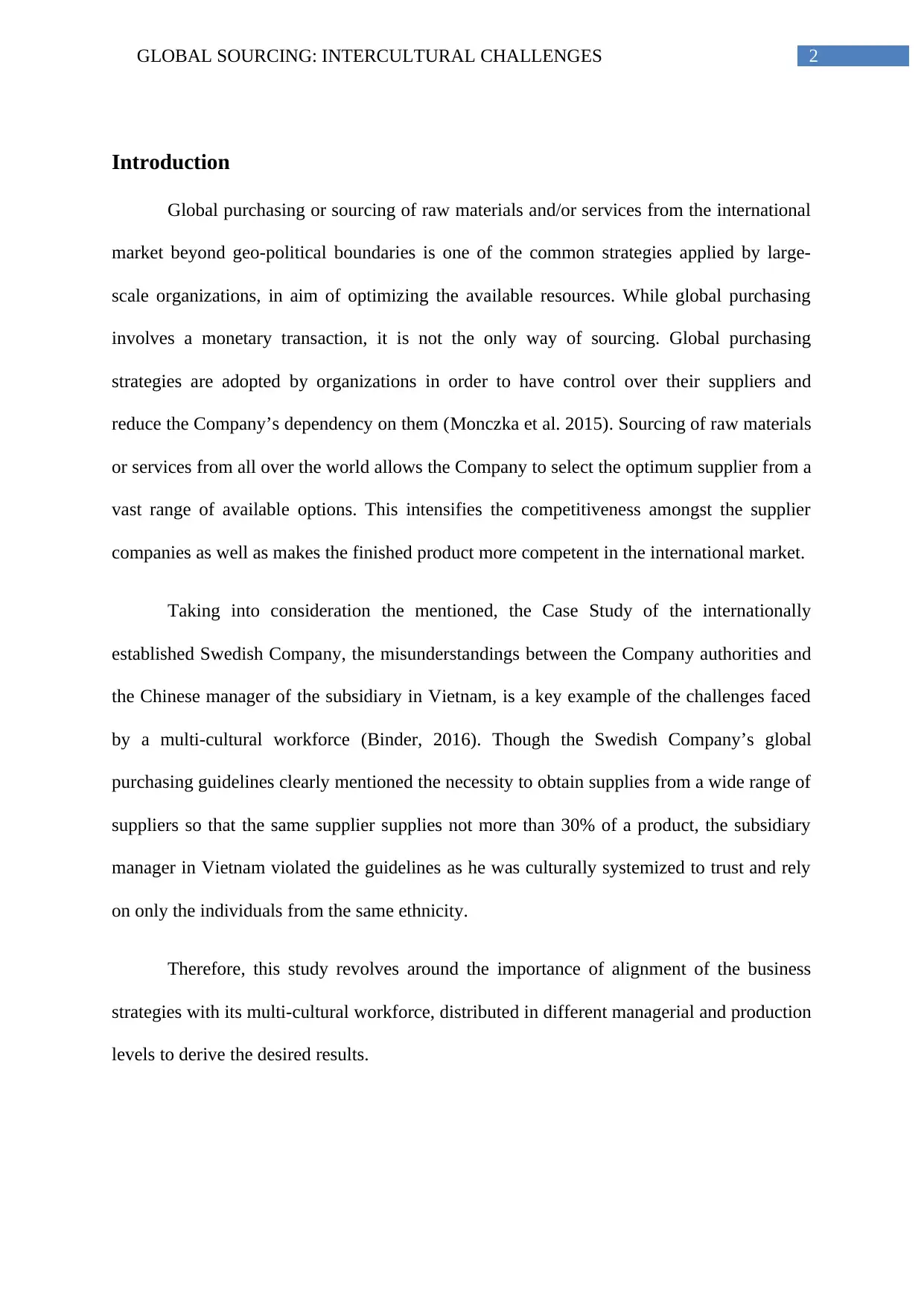
2GLOBAL SOURCING: INTERCULTURAL CHALLENGES
Introduction
Global purchasing or sourcing of raw materials and/or services from the international
market beyond geo-political boundaries is one of the common strategies applied by large-
scale organizations, in aim of optimizing the available resources. While global purchasing
involves a monetary transaction, it is not the only way of sourcing. Global purchasing
strategies are adopted by organizations in order to have control over their suppliers and
reduce the Company’s dependency on them (Monczka et al. 2015). Sourcing of raw materials
or services from all over the world allows the Company to select the optimum supplier from a
vast range of available options. This intensifies the competitiveness amongst the supplier
companies as well as makes the finished product more competent in the international market.
Taking into consideration the mentioned, the Case Study of the internationally
established Swedish Company, the misunderstandings between the Company authorities and
the Chinese manager of the subsidiary in Vietnam, is a key example of the challenges faced
by a multi-cultural workforce (Binder, 2016). Though the Swedish Company’s global
purchasing guidelines clearly mentioned the necessity to obtain supplies from a wide range of
suppliers so that the same supplier supplies not more than 30% of a product, the subsidiary
manager in Vietnam violated the guidelines as he was culturally systemized to trust and rely
on only the individuals from the same ethnicity.
Therefore, this study revolves around the importance of alignment of the business
strategies with its multi-cultural workforce, distributed in different managerial and production
levels to derive the desired results.
Introduction
Global purchasing or sourcing of raw materials and/or services from the international
market beyond geo-political boundaries is one of the common strategies applied by large-
scale organizations, in aim of optimizing the available resources. While global purchasing
involves a monetary transaction, it is not the only way of sourcing. Global purchasing
strategies are adopted by organizations in order to have control over their suppliers and
reduce the Company’s dependency on them (Monczka et al. 2015). Sourcing of raw materials
or services from all over the world allows the Company to select the optimum supplier from a
vast range of available options. This intensifies the competitiveness amongst the supplier
companies as well as makes the finished product more competent in the international market.
Taking into consideration the mentioned, the Case Study of the internationally
established Swedish Company, the misunderstandings between the Company authorities and
the Chinese manager of the subsidiary in Vietnam, is a key example of the challenges faced
by a multi-cultural workforce (Binder, 2016). Though the Swedish Company’s global
purchasing guidelines clearly mentioned the necessity to obtain supplies from a wide range of
suppliers so that the same supplier supplies not more than 30% of a product, the subsidiary
manager in Vietnam violated the guidelines as he was culturally systemized to trust and rely
on only the individuals from the same ethnicity.
Therefore, this study revolves around the importance of alignment of the business
strategies with its multi-cultural workforce, distributed in different managerial and production
levels to derive the desired results.
⊘ This is a preview!⊘
Do you want full access?
Subscribe today to unlock all pages.

Trusted by 1+ million students worldwide
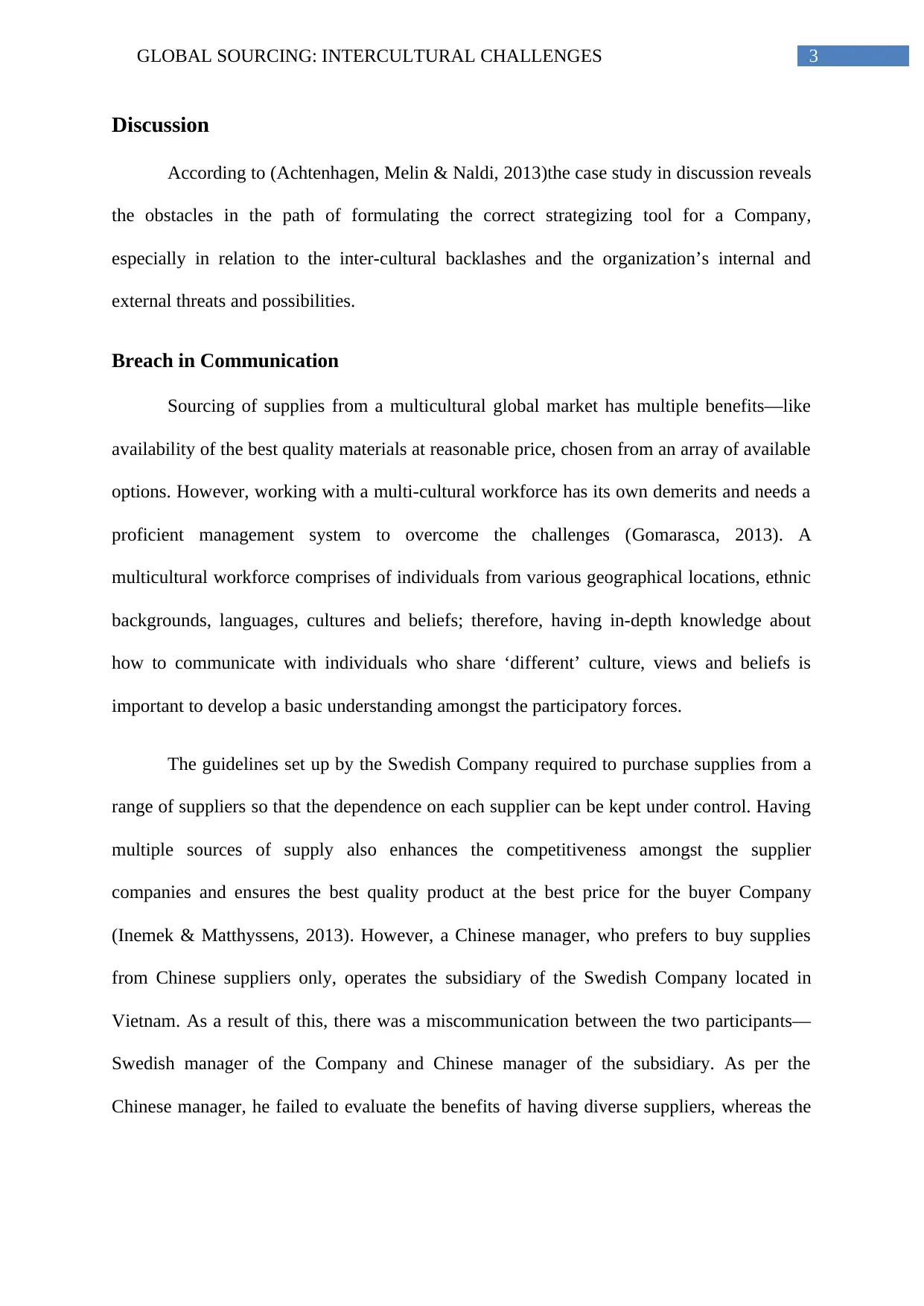
3GLOBAL SOURCING: INTERCULTURAL CHALLENGES
Discussion
According to (Achtenhagen, Melin & Naldi, 2013)the case study in discussion reveals
the obstacles in the path of formulating the correct strategizing tool for a Company,
especially in relation to the inter-cultural backlashes and the organization’s internal and
external threats and possibilities.
Breach in Communication
Sourcing of supplies from a multicultural global market has multiple benefits—like
availability of the best quality materials at reasonable price, chosen from an array of available
options. However, working with a multi-cultural workforce has its own demerits and needs a
proficient management system to overcome the challenges (Gomarasca, 2013). A
multicultural workforce comprises of individuals from various geographical locations, ethnic
backgrounds, languages, cultures and beliefs; therefore, having in-depth knowledge about
how to communicate with individuals who share ‘different’ culture, views and beliefs is
important to develop a basic understanding amongst the participatory forces.
The guidelines set up by the Swedish Company required to purchase supplies from a
range of suppliers so that the dependence on each supplier can be kept under control. Having
multiple sources of supply also enhances the competitiveness amongst the supplier
companies and ensures the best quality product at the best price for the buyer Company
(Inemek & Matthyssens, 2013). However, a Chinese manager, who prefers to buy supplies
from Chinese suppliers only, operates the subsidiary of the Swedish Company located in
Vietnam. As a result of this, there was a miscommunication between the two participants—
Swedish manager of the Company and Chinese manager of the subsidiary. As per the
Chinese manager, he failed to evaluate the benefits of having diverse suppliers, whereas the
Discussion
According to (Achtenhagen, Melin & Naldi, 2013)the case study in discussion reveals
the obstacles in the path of formulating the correct strategizing tool for a Company,
especially in relation to the inter-cultural backlashes and the organization’s internal and
external threats and possibilities.
Breach in Communication
Sourcing of supplies from a multicultural global market has multiple benefits—like
availability of the best quality materials at reasonable price, chosen from an array of available
options. However, working with a multi-cultural workforce has its own demerits and needs a
proficient management system to overcome the challenges (Gomarasca, 2013). A
multicultural workforce comprises of individuals from various geographical locations, ethnic
backgrounds, languages, cultures and beliefs; therefore, having in-depth knowledge about
how to communicate with individuals who share ‘different’ culture, views and beliefs is
important to develop a basic understanding amongst the participatory forces.
The guidelines set up by the Swedish Company required to purchase supplies from a
range of suppliers so that the dependence on each supplier can be kept under control. Having
multiple sources of supply also enhances the competitiveness amongst the supplier
companies and ensures the best quality product at the best price for the buyer Company
(Inemek & Matthyssens, 2013). However, a Chinese manager, who prefers to buy supplies
from Chinese suppliers only, operates the subsidiary of the Swedish Company located in
Vietnam. As a result of this, there was a miscommunication between the two participants—
Swedish manager of the Company and Chinese manager of the subsidiary. As per the
Chinese manager, he failed to evaluate the benefits of having diverse suppliers, whereas the
Paraphrase This Document
Need a fresh take? Get an instant paraphrase of this document with our AI Paraphraser
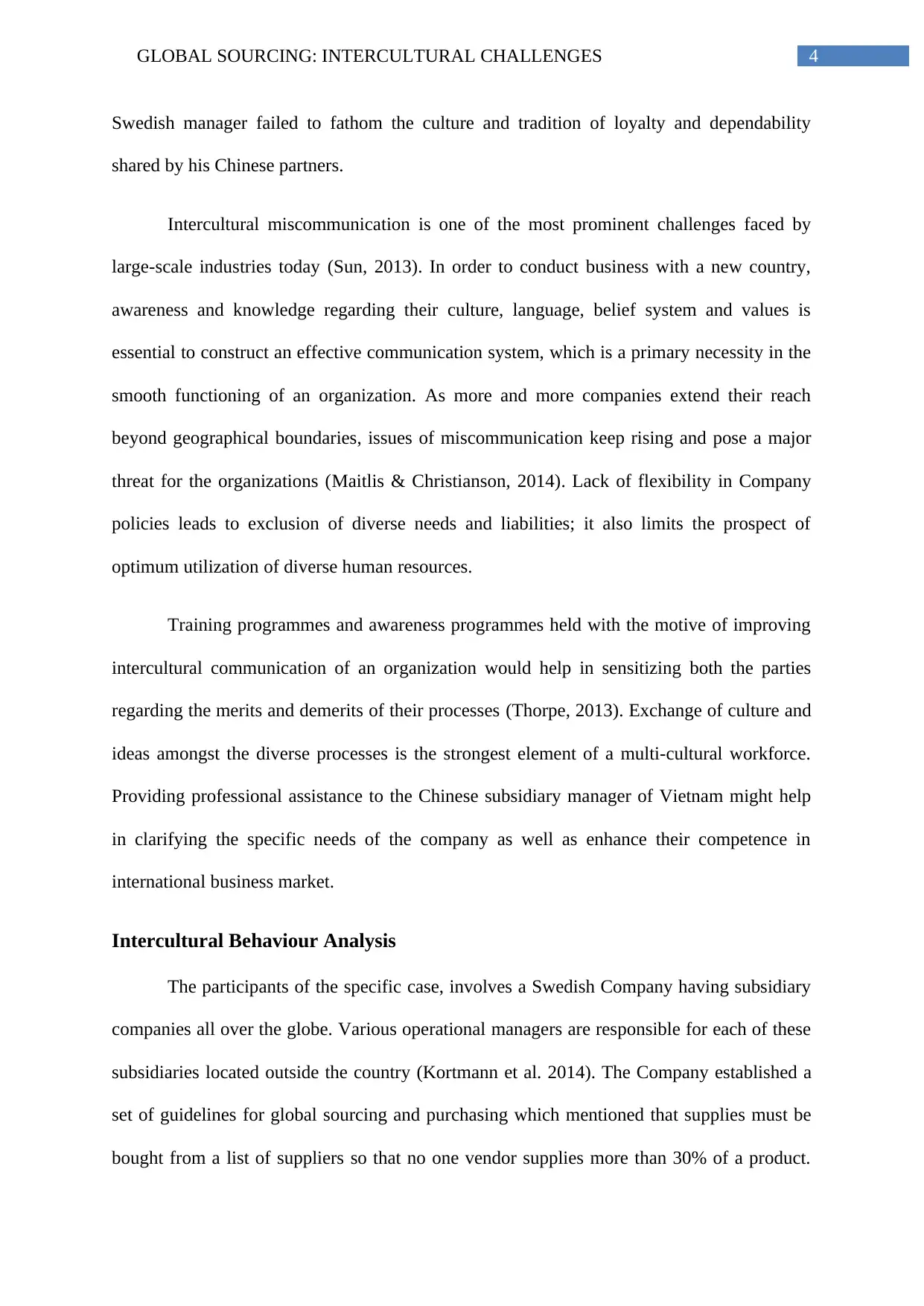
4GLOBAL SOURCING: INTERCULTURAL CHALLENGES
Swedish manager failed to fathom the culture and tradition of loyalty and dependability
shared by his Chinese partners.
Intercultural miscommunication is one of the most prominent challenges faced by
large-scale industries today (Sun, 2013). In order to conduct business with a new country,
awareness and knowledge regarding their culture, language, belief system and values is
essential to construct an effective communication system, which is a primary necessity in the
smooth functioning of an organization. As more and more companies extend their reach
beyond geographical boundaries, issues of miscommunication keep rising and pose a major
threat for the organizations (Maitlis & Christianson, 2014). Lack of flexibility in Company
policies leads to exclusion of diverse needs and liabilities; it also limits the prospect of
optimum utilization of diverse human resources.
Training programmes and awareness programmes held with the motive of improving
intercultural communication of an organization would help in sensitizing both the parties
regarding the merits and demerits of their processes (Thorpe, 2013). Exchange of culture and
ideas amongst the diverse processes is the strongest element of a multi-cultural workforce.
Providing professional assistance to the Chinese subsidiary manager of Vietnam might help
in clarifying the specific needs of the company as well as enhance their competence in
international business market.
Intercultural Behaviour Analysis
The participants of the specific case, involves a Swedish Company having subsidiary
companies all over the globe. Various operational managers are responsible for each of these
subsidiaries located outside the country (Kortmann et al. 2014). The Company established a
set of guidelines for global sourcing and purchasing which mentioned that supplies must be
bought from a list of suppliers so that no one vendor supplies more than 30% of a product.
Swedish manager failed to fathom the culture and tradition of loyalty and dependability
shared by his Chinese partners.
Intercultural miscommunication is one of the most prominent challenges faced by
large-scale industries today (Sun, 2013). In order to conduct business with a new country,
awareness and knowledge regarding their culture, language, belief system and values is
essential to construct an effective communication system, which is a primary necessity in the
smooth functioning of an organization. As more and more companies extend their reach
beyond geographical boundaries, issues of miscommunication keep rising and pose a major
threat for the organizations (Maitlis & Christianson, 2014). Lack of flexibility in Company
policies leads to exclusion of diverse needs and liabilities; it also limits the prospect of
optimum utilization of diverse human resources.
Training programmes and awareness programmes held with the motive of improving
intercultural communication of an organization would help in sensitizing both the parties
regarding the merits and demerits of their processes (Thorpe, 2013). Exchange of culture and
ideas amongst the diverse processes is the strongest element of a multi-cultural workforce.
Providing professional assistance to the Chinese subsidiary manager of Vietnam might help
in clarifying the specific needs of the company as well as enhance their competence in
international business market.
Intercultural Behaviour Analysis
The participants of the specific case, involves a Swedish Company having subsidiary
companies all over the globe. Various operational managers are responsible for each of these
subsidiaries located outside the country (Kortmann et al. 2014). The Company established a
set of guidelines for global sourcing and purchasing which mentioned that supplies must be
bought from a list of suppliers so that no one vendor supplies more than 30% of a product.
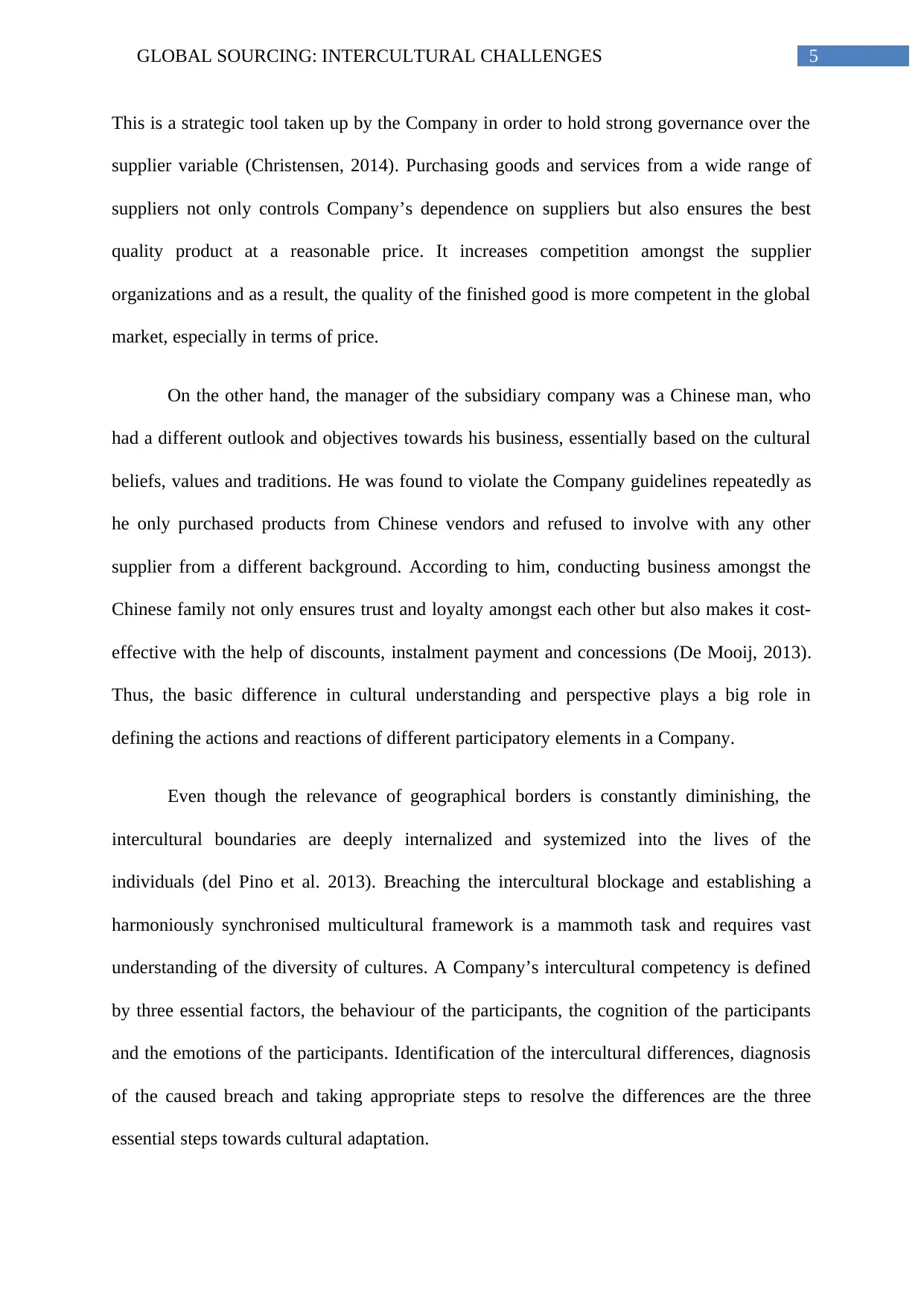
5GLOBAL SOURCING: INTERCULTURAL CHALLENGES
This is a strategic tool taken up by the Company in order to hold strong governance over the
supplier variable (Christensen, 2014). Purchasing goods and services from a wide range of
suppliers not only controls Company’s dependence on suppliers but also ensures the best
quality product at a reasonable price. It increases competition amongst the supplier
organizations and as a result, the quality of the finished good is more competent in the global
market, especially in terms of price.
On the other hand, the manager of the subsidiary company was a Chinese man, who
had a different outlook and objectives towards his business, essentially based on the cultural
beliefs, values and traditions. He was found to violate the Company guidelines repeatedly as
he only purchased products from Chinese vendors and refused to involve with any other
supplier from a different background. According to him, conducting business amongst the
Chinese family not only ensures trust and loyalty amongst each other but also makes it cost-
effective with the help of discounts, instalment payment and concessions (De Mooij, 2013).
Thus, the basic difference in cultural understanding and perspective plays a big role in
defining the actions and reactions of different participatory elements in a Company.
Even though the relevance of geographical borders is constantly diminishing, the
intercultural boundaries are deeply internalized and systemized into the lives of the
individuals (del Pino et al. 2013). Breaching the intercultural blockage and establishing a
harmoniously synchronised multicultural framework is a mammoth task and requires vast
understanding of the diversity of cultures. A Company’s intercultural competency is defined
by three essential factors, the behaviour of the participants, the cognition of the participants
and the emotions of the participants. Identification of the intercultural differences, diagnosis
of the caused breach and taking appropriate steps to resolve the differences are the three
essential steps towards cultural adaptation.
This is a strategic tool taken up by the Company in order to hold strong governance over the
supplier variable (Christensen, 2014). Purchasing goods and services from a wide range of
suppliers not only controls Company’s dependence on suppliers but also ensures the best
quality product at a reasonable price. It increases competition amongst the supplier
organizations and as a result, the quality of the finished good is more competent in the global
market, especially in terms of price.
On the other hand, the manager of the subsidiary company was a Chinese man, who
had a different outlook and objectives towards his business, essentially based on the cultural
beliefs, values and traditions. He was found to violate the Company guidelines repeatedly as
he only purchased products from Chinese vendors and refused to involve with any other
supplier from a different background. According to him, conducting business amongst the
Chinese family not only ensures trust and loyalty amongst each other but also makes it cost-
effective with the help of discounts, instalment payment and concessions (De Mooij, 2013).
Thus, the basic difference in cultural understanding and perspective plays a big role in
defining the actions and reactions of different participatory elements in a Company.
Even though the relevance of geographical borders is constantly diminishing, the
intercultural boundaries are deeply internalized and systemized into the lives of the
individuals (del Pino et al. 2013). Breaching the intercultural blockage and establishing a
harmoniously synchronised multicultural framework is a mammoth task and requires vast
understanding of the diversity of cultures. A Company’s intercultural competency is defined
by three essential factors, the behaviour of the participants, the cognition of the participants
and the emotions of the participants. Identification of the intercultural differences, diagnosis
of the caused breach and taking appropriate steps to resolve the differences are the three
essential steps towards cultural adaptation.
⊘ This is a preview!⊘
Do you want full access?
Subscribe today to unlock all pages.

Trusted by 1+ million students worldwide
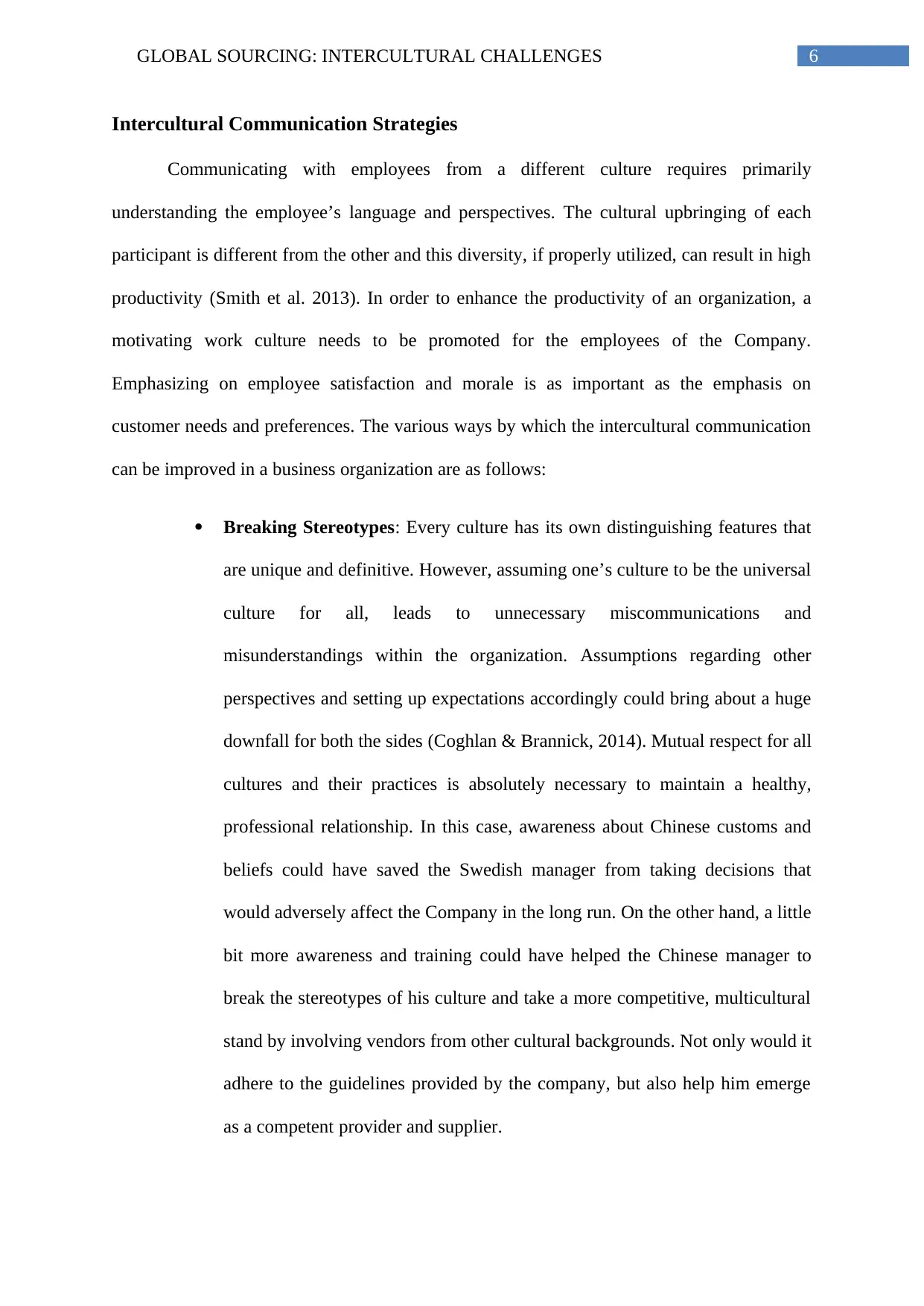
6GLOBAL SOURCING: INTERCULTURAL CHALLENGES
Intercultural Communication Strategies
Communicating with employees from a different culture requires primarily
understanding the employee’s language and perspectives. The cultural upbringing of each
participant is different from the other and this diversity, if properly utilized, can result in high
productivity (Smith et al. 2013). In order to enhance the productivity of an organization, a
motivating work culture needs to be promoted for the employees of the Company.
Emphasizing on employee satisfaction and morale is as important as the emphasis on
customer needs and preferences. The various ways by which the intercultural communication
can be improved in a business organization are as follows:
Breaking Stereotypes: Every culture has its own distinguishing features that
are unique and definitive. However, assuming one’s culture to be the universal
culture for all, leads to unnecessary miscommunications and
misunderstandings within the organization. Assumptions regarding other
perspectives and setting up expectations accordingly could bring about a huge
downfall for both the sides (Coghlan & Brannick, 2014). Mutual respect for all
cultures and their practices is absolutely necessary to maintain a healthy,
professional relationship. In this case, awareness about Chinese customs and
beliefs could have saved the Swedish manager from taking decisions that
would adversely affect the Company in the long run. On the other hand, a little
bit more awareness and training could have helped the Chinese manager to
break the stereotypes of his culture and take a more competitive, multicultural
stand by involving vendors from other cultural backgrounds. Not only would it
adhere to the guidelines provided by the company, but also help him emerge
as a competent provider and supplier.
Intercultural Communication Strategies
Communicating with employees from a different culture requires primarily
understanding the employee’s language and perspectives. The cultural upbringing of each
participant is different from the other and this diversity, if properly utilized, can result in high
productivity (Smith et al. 2013). In order to enhance the productivity of an organization, a
motivating work culture needs to be promoted for the employees of the Company.
Emphasizing on employee satisfaction and morale is as important as the emphasis on
customer needs and preferences. The various ways by which the intercultural communication
can be improved in a business organization are as follows:
Breaking Stereotypes: Every culture has its own distinguishing features that
are unique and definitive. However, assuming one’s culture to be the universal
culture for all, leads to unnecessary miscommunications and
misunderstandings within the organization. Assumptions regarding other
perspectives and setting up expectations accordingly could bring about a huge
downfall for both the sides (Coghlan & Brannick, 2014). Mutual respect for all
cultures and their practices is absolutely necessary to maintain a healthy,
professional relationship. In this case, awareness about Chinese customs and
beliefs could have saved the Swedish manager from taking decisions that
would adversely affect the Company in the long run. On the other hand, a little
bit more awareness and training could have helped the Chinese manager to
break the stereotypes of his culture and take a more competitive, multicultural
stand by involving vendors from other cultural backgrounds. Not only would it
adhere to the guidelines provided by the company, but also help him emerge
as a competent provider and supplier.
Paraphrase This Document
Need a fresh take? Get an instant paraphrase of this document with our AI Paraphraser
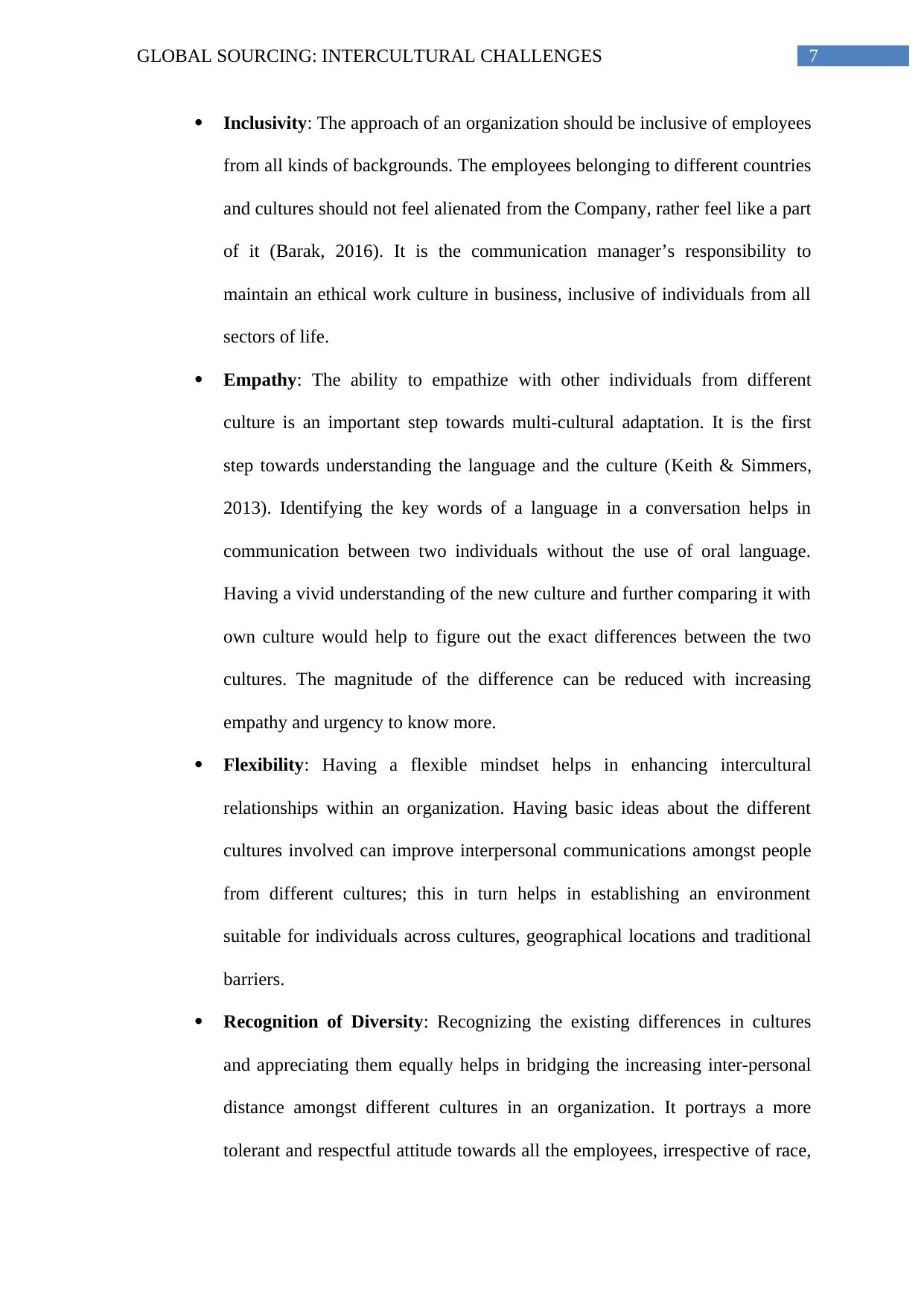
7GLOBAL SOURCING: INTERCULTURAL CHALLENGES
Inclusivity: The approach of an organization should be inclusive of employees
from all kinds of backgrounds. The employees belonging to different countries
and cultures should not feel alienated from the Company, rather feel like a part
of it (Barak, 2016). It is the communication manager’s responsibility to
maintain an ethical work culture in business, inclusive of individuals from all
sectors of life.
Empathy: The ability to empathize with other individuals from different
culture is an important step towards multi-cultural adaptation. It is the first
step towards understanding the language and the culture (Keith & Simmers,
2013). Identifying the key words of a language in a conversation helps in
communication between two individuals without the use of oral language.
Having a vivid understanding of the new culture and further comparing it with
own culture would help to figure out the exact differences between the two
cultures. The magnitude of the difference can be reduced with increasing
empathy and urgency to know more.
Flexibility: Having a flexible mindset helps in enhancing intercultural
relationships within an organization. Having basic ideas about the different
cultures involved can improve interpersonal communications amongst people
from different cultures; this in turn helps in establishing an environment
suitable for individuals across cultures, geographical locations and traditional
barriers.
Recognition of Diversity: Recognizing the existing differences in cultures
and appreciating them equally helps in bridging the increasing inter-personal
distance amongst different cultures in an organization. It portrays a more
tolerant and respectful attitude towards all the employees, irrespective of race,
Inclusivity: The approach of an organization should be inclusive of employees
from all kinds of backgrounds. The employees belonging to different countries
and cultures should not feel alienated from the Company, rather feel like a part
of it (Barak, 2016). It is the communication manager’s responsibility to
maintain an ethical work culture in business, inclusive of individuals from all
sectors of life.
Empathy: The ability to empathize with other individuals from different
culture is an important step towards multi-cultural adaptation. It is the first
step towards understanding the language and the culture (Keith & Simmers,
2013). Identifying the key words of a language in a conversation helps in
communication between two individuals without the use of oral language.
Having a vivid understanding of the new culture and further comparing it with
own culture would help to figure out the exact differences between the two
cultures. The magnitude of the difference can be reduced with increasing
empathy and urgency to know more.
Flexibility: Having a flexible mindset helps in enhancing intercultural
relationships within an organization. Having basic ideas about the different
cultures involved can improve interpersonal communications amongst people
from different cultures; this in turn helps in establishing an environment
suitable for individuals across cultures, geographical locations and traditional
barriers.
Recognition of Diversity: Recognizing the existing differences in cultures
and appreciating them equally helps in bridging the increasing inter-personal
distance amongst different cultures in an organization. It portrays a more
tolerant and respectful attitude towards all the employees, irrespective of race,
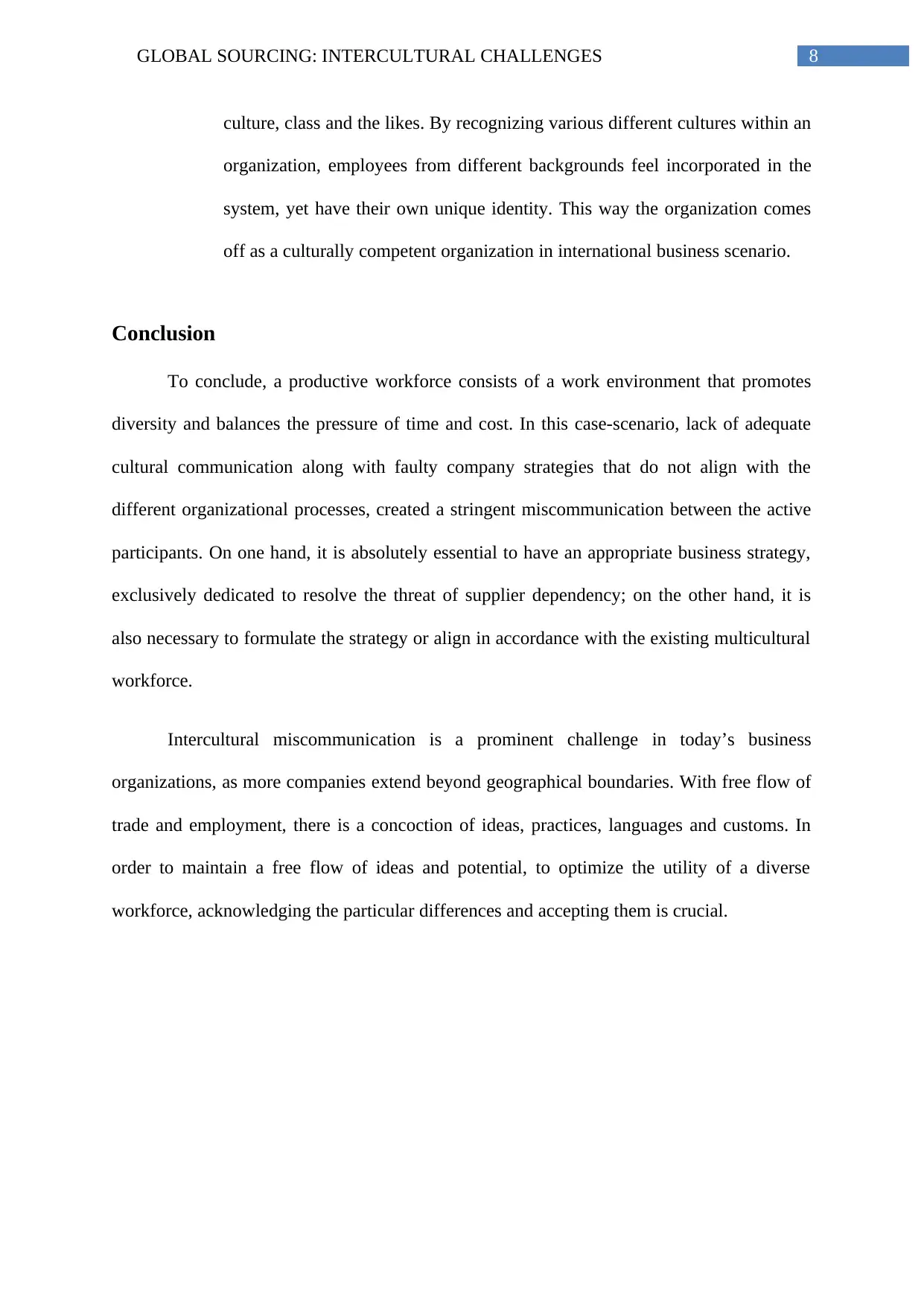
8GLOBAL SOURCING: INTERCULTURAL CHALLENGES
culture, class and the likes. By recognizing various different cultures within an
organization, employees from different backgrounds feel incorporated in the
system, yet have their own unique identity. This way the organization comes
off as a culturally competent organization in international business scenario.
Conclusion
To conclude, a productive workforce consists of a work environment that promotes
diversity and balances the pressure of time and cost. In this case-scenario, lack of adequate
cultural communication along with faulty company strategies that do not align with the
different organizational processes, created a stringent miscommunication between the active
participants. On one hand, it is absolutely essential to have an appropriate business strategy,
exclusively dedicated to resolve the threat of supplier dependency; on the other hand, it is
also necessary to formulate the strategy or align in accordance with the existing multicultural
workforce.
Intercultural miscommunication is a prominent challenge in today’s business
organizations, as more companies extend beyond geographical boundaries. With free flow of
trade and employment, there is a concoction of ideas, practices, languages and customs. In
order to maintain a free flow of ideas and potential, to optimize the utility of a diverse
workforce, acknowledging the particular differences and accepting them is crucial.
culture, class and the likes. By recognizing various different cultures within an
organization, employees from different backgrounds feel incorporated in the
system, yet have their own unique identity. This way the organization comes
off as a culturally competent organization in international business scenario.
Conclusion
To conclude, a productive workforce consists of a work environment that promotes
diversity and balances the pressure of time and cost. In this case-scenario, lack of adequate
cultural communication along with faulty company strategies that do not align with the
different organizational processes, created a stringent miscommunication between the active
participants. On one hand, it is absolutely essential to have an appropriate business strategy,
exclusively dedicated to resolve the threat of supplier dependency; on the other hand, it is
also necessary to formulate the strategy or align in accordance with the existing multicultural
workforce.
Intercultural miscommunication is a prominent challenge in today’s business
organizations, as more companies extend beyond geographical boundaries. With free flow of
trade and employment, there is a concoction of ideas, practices, languages and customs. In
order to maintain a free flow of ideas and potential, to optimize the utility of a diverse
workforce, acknowledging the particular differences and accepting them is crucial.
⊘ This is a preview!⊘
Do you want full access?
Subscribe today to unlock all pages.

Trusted by 1+ million students worldwide
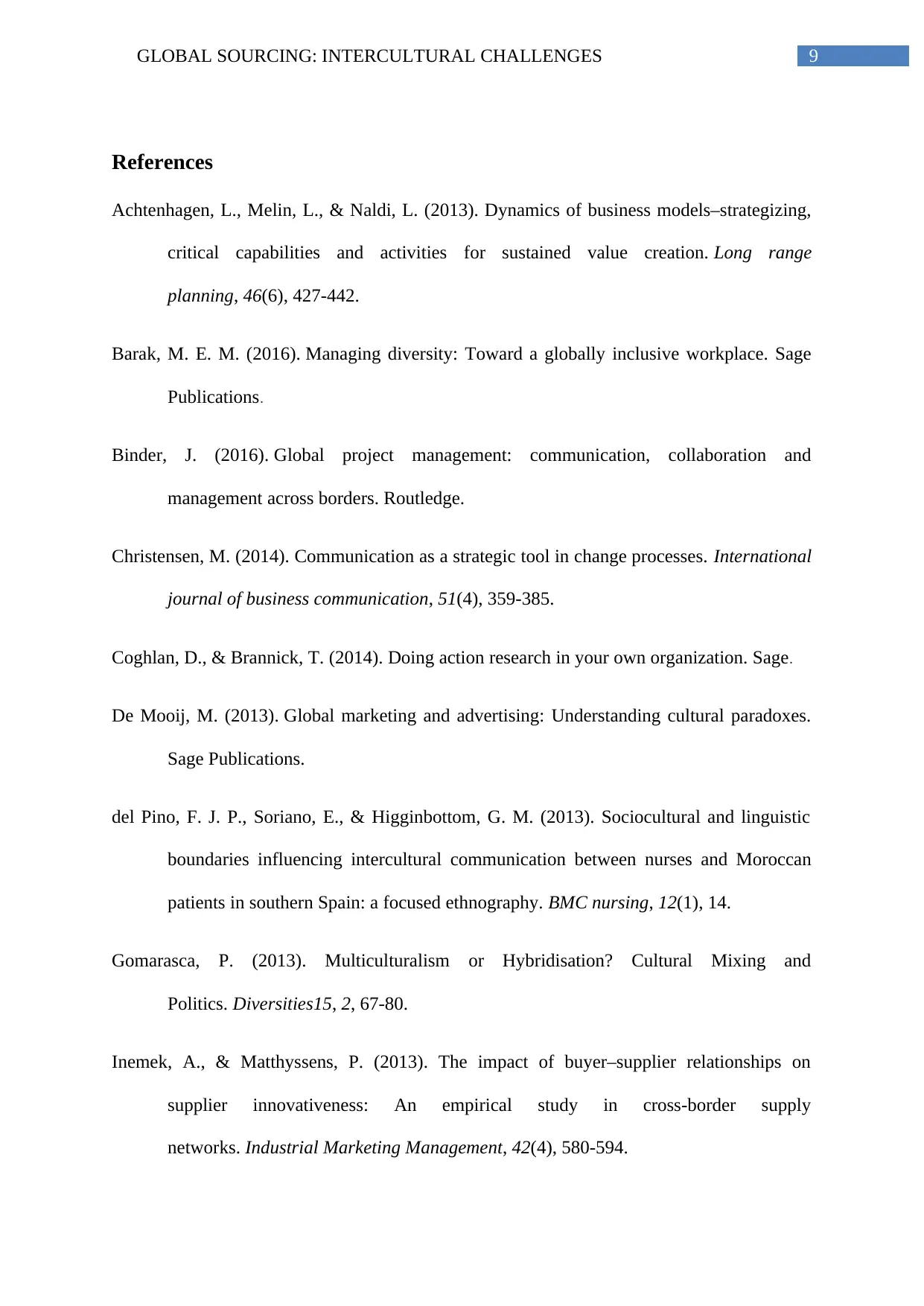
9GLOBAL SOURCING: INTERCULTURAL CHALLENGES
References
Achtenhagen, L., Melin, L., & Naldi, L. (2013). Dynamics of business models–strategizing,
critical capabilities and activities for sustained value creation. Long range
planning, 46(6), 427-442.
Barak, M. E. M. (2016). Managing diversity: Toward a globally inclusive workplace. Sage
Publications.
Binder, J. (2016). Global project management: communication, collaboration and
management across borders. Routledge.
Christensen, M. (2014). Communication as a strategic tool in change processes. International
journal of business communication, 51(4), 359-385.
Coghlan, D., & Brannick, T. (2014). Doing action research in your own organization. Sage.
De Mooij, M. (2013). Global marketing and advertising: Understanding cultural paradoxes.
Sage Publications.
del Pino, F. J. P., Soriano, E., & Higginbottom, G. M. (2013). Sociocultural and linguistic
boundaries influencing intercultural communication between nurses and Moroccan
patients in southern Spain: a focused ethnography. BMC nursing, 12(1), 14.
Gomarasca, P. (2013). Multiculturalism or Hybridisation? Cultural Mixing and
Politics. Diversities15, 2, 67-80.
Inemek, A., & Matthyssens, P. (2013). The impact of buyer–supplier relationships on
supplier innovativeness: An empirical study in cross-border supply
networks. Industrial Marketing Management, 42(4), 580-594.
References
Achtenhagen, L., Melin, L., & Naldi, L. (2013). Dynamics of business models–strategizing,
critical capabilities and activities for sustained value creation. Long range
planning, 46(6), 427-442.
Barak, M. E. M. (2016). Managing diversity: Toward a globally inclusive workplace. Sage
Publications.
Binder, J. (2016). Global project management: communication, collaboration and
management across borders. Routledge.
Christensen, M. (2014). Communication as a strategic tool in change processes. International
journal of business communication, 51(4), 359-385.
Coghlan, D., & Brannick, T. (2014). Doing action research in your own organization. Sage.
De Mooij, M. (2013). Global marketing and advertising: Understanding cultural paradoxes.
Sage Publications.
del Pino, F. J. P., Soriano, E., & Higginbottom, G. M. (2013). Sociocultural and linguistic
boundaries influencing intercultural communication between nurses and Moroccan
patients in southern Spain: a focused ethnography. BMC nursing, 12(1), 14.
Gomarasca, P. (2013). Multiculturalism or Hybridisation? Cultural Mixing and
Politics. Diversities15, 2, 67-80.
Inemek, A., & Matthyssens, P. (2013). The impact of buyer–supplier relationships on
supplier innovativeness: An empirical study in cross-border supply
networks. Industrial Marketing Management, 42(4), 580-594.
Paraphrase This Document
Need a fresh take? Get an instant paraphrase of this document with our AI Paraphraser
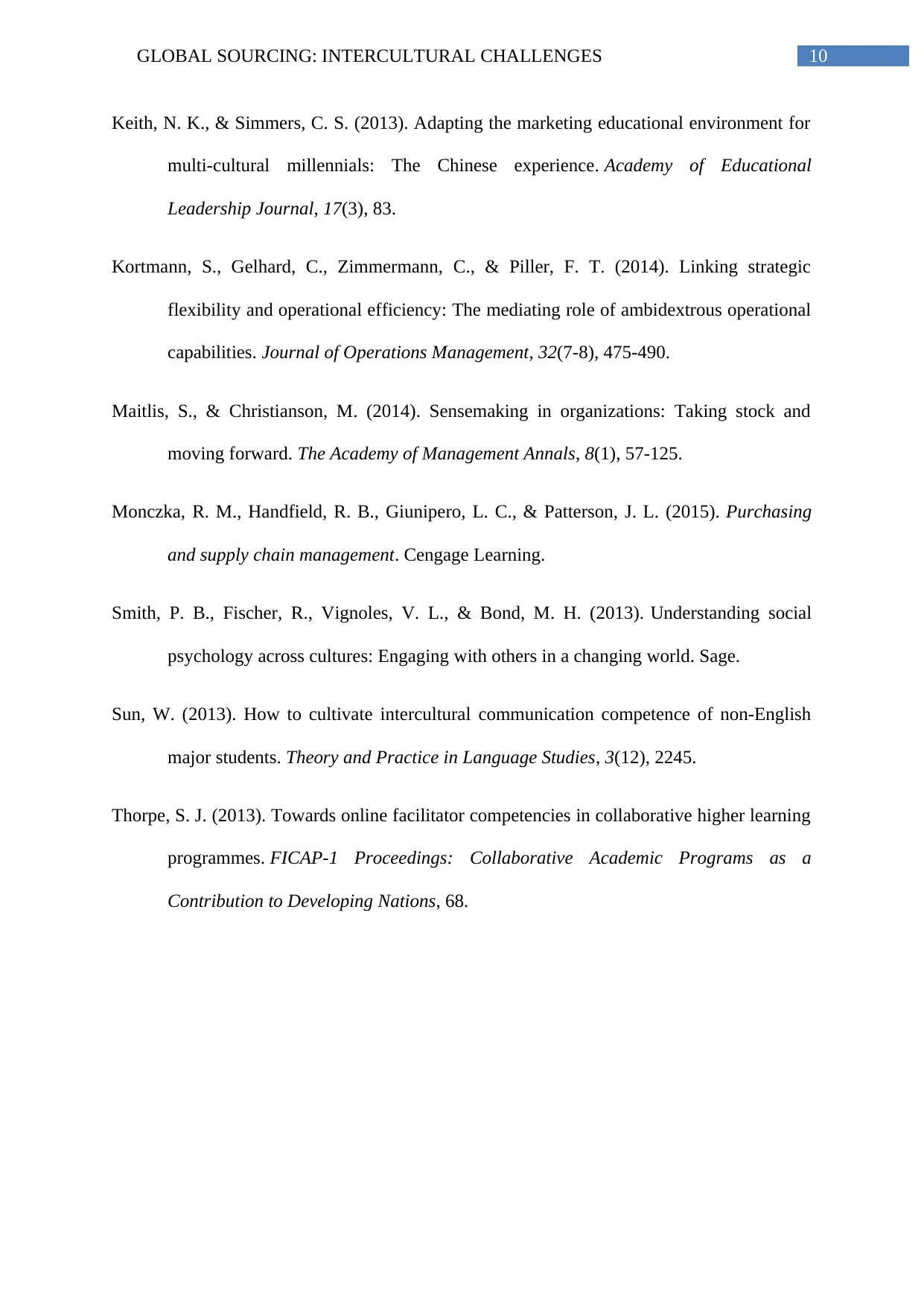
10GLOBAL SOURCING: INTERCULTURAL CHALLENGES
Keith, N. K., & Simmers, C. S. (2013). Adapting the marketing educational environment for
multi-cultural millennials: The Chinese experience. Academy of Educational
Leadership Journal, 17(3), 83.
Kortmann, S., Gelhard, C., Zimmermann, C., & Piller, F. T. (2014). Linking strategic
flexibility and operational efficiency: The mediating role of ambidextrous operational
capabilities. Journal of Operations Management, 32(7-8), 475-490.
Maitlis, S., & Christianson, M. (2014). Sensemaking in organizations: Taking stock and
moving forward. The Academy of Management Annals, 8(1), 57-125.
Monczka, R. M., Handfield, R. B., Giunipero, L. C., & Patterson, J. L. (2015). Purchasing
and supply chain management. Cengage Learning.
Smith, P. B., Fischer, R., Vignoles, V. L., & Bond, M. H. (2013). Understanding social
psychology across cultures: Engaging with others in a changing world. Sage.
Sun, W. (2013). How to cultivate intercultural communication competence of non-English
major students. Theory and Practice in Language Studies, 3(12), 2245.
Thorpe, S. J. (2013). Towards online facilitator competencies in collaborative higher learning
programmes. FICAP-1 Proceedings: Collaborative Academic Programs as a
Contribution to Developing Nations, 68.
Keith, N. K., & Simmers, C. S. (2013). Adapting the marketing educational environment for
multi-cultural millennials: The Chinese experience. Academy of Educational
Leadership Journal, 17(3), 83.
Kortmann, S., Gelhard, C., Zimmermann, C., & Piller, F. T. (2014). Linking strategic
flexibility and operational efficiency: The mediating role of ambidextrous operational
capabilities. Journal of Operations Management, 32(7-8), 475-490.
Maitlis, S., & Christianson, M. (2014). Sensemaking in organizations: Taking stock and
moving forward. The Academy of Management Annals, 8(1), 57-125.
Monczka, R. M., Handfield, R. B., Giunipero, L. C., & Patterson, J. L. (2015). Purchasing
and supply chain management. Cengage Learning.
Smith, P. B., Fischer, R., Vignoles, V. L., & Bond, M. H. (2013). Understanding social
psychology across cultures: Engaging with others in a changing world. Sage.
Sun, W. (2013). How to cultivate intercultural communication competence of non-English
major students. Theory and Practice in Language Studies, 3(12), 2245.
Thorpe, S. J. (2013). Towards online facilitator competencies in collaborative higher learning
programmes. FICAP-1 Proceedings: Collaborative Academic Programs as a
Contribution to Developing Nations, 68.
1 out of 11
Related Documents
Your All-in-One AI-Powered Toolkit for Academic Success.
+13062052269
info@desklib.com
Available 24*7 on WhatsApp / Email
![[object Object]](/_next/static/media/star-bottom.7253800d.svg)
Unlock your academic potential
Copyright © 2020–2025 A2Z Services. All Rights Reserved. Developed and managed by ZUCOL.
![Intercultural Business Communication Analysis Report - [Course Name]](/_next/image/?url=https%3A%2F%2Fdesklib.com%2Fmedia%2Fimages%2Fmh%2F6bdbf48c819449968e15eda2e27fc2fb.jpg&w=256&q=75)




